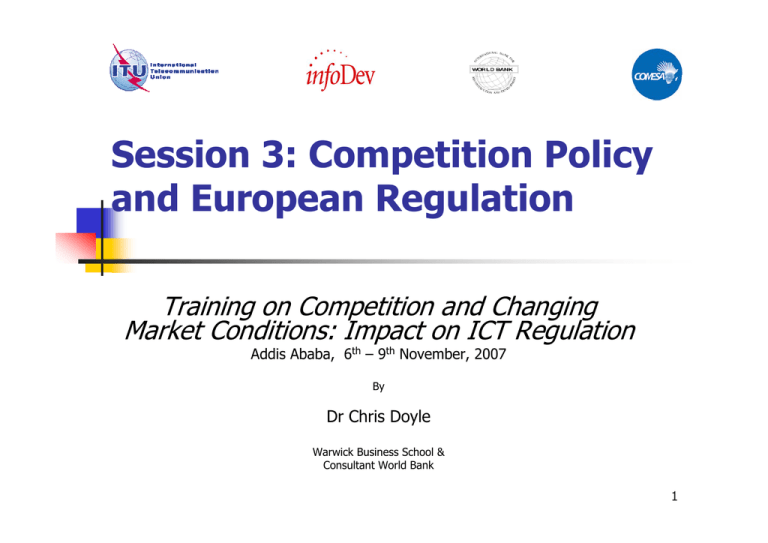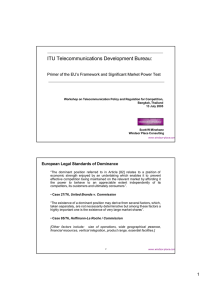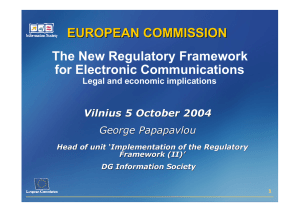Session 3: Competition Policy and European Regulation Training on Competition and Changing
advertisement

Session 3: Competition Policy and European Regulation Training on Competition and Changing Market Conditions: Impact on ICT Regulation Addis Ababa, 6th – 9th November, 2007 By Dr Chris Doyle Warwick Business School & Consultant World Bank 1 Case study: The application of ex ante regulation in the EU – present and future 2 The current framework: Key Regulatory Directives (2002) Framework Directive Authorisation Directive Licensing regime – light-handed Access Directive Outlines principles and objectives Interconnection etc Universal Service Directive Social objectives and protecting certain end users 3 Framework Directive Provisions for dealing with NRAs and their tasks Article 7 procedures for SMP notifications, harmonisation and coordination Introduces SMP concept Market definition procedure Commission right of veto where NRA defines different relevant market and designates SMP and there is a “barrier to the single market” or “serious doubts” about compatibility with Community law and objectives of NRA (Article 8) NRA to identify markets guided by Commission Recommendation Market analysis procedure NRA to assess competition in market and identify SMP operators taking utmost account of Commission Guidelines 4 Significant Market Power “…there is not effective competition, i.e. in markets where there are one or more undertakings with significant market power” (Recital 27 Framework Directive) “An undertaking shall be deemed to have significant market power if, either individually or jointly with others, it enjoys a position equivalent to dominance, that is to say a position of economic strength affording it the power to behave to an appreciable extent independently of competitors, customers and ultimately consumers.” (Article 14(2) Framework Directive) (emphasis added) “Where a national regulatory authority determines that a relevant market is not effectively competitive, it shall identify undertakings with significant market power on that market” (Article 16(4) Framework Directive) (emphasis added) 5 Recommended markets 2002 Retail 1. Access to fixed public telephone network residential 2. Access to fixed public telephone network non-residential 3. Public local and/or national telephony services fixed, residential 4. Public local international telephony services fixed, residential 5. Public local and/or national telephony services fixed, nonresidential 6. Public local international telephony services fixed, non-residential 7. Minimum set of leased lines, up to and including 2Mb/sec Wholesale 8. Call origination, fixed 9. Call termination, fixed 10. Transit services, fixed 11. Unbundled access (inc. shared access) for broadband and voice 12. Broadband access – bitstream and equivalent 13. Terminating segments of leased lines 14. Trunk segments, leased lines 15. Access and call origination, public mobile 16. Voice call termination, mobile 17. National market for international roaming on mobile 18. Broadcasting transmission services 6 Recommended markets 2007 (proposed) Retail 1. Access to fixed public telephone network residential and non-residential Wholesale 2. Call termination, fixed 3. Call origination, fixed 4. Transit services, fixed 5. Unbundled access (inc. shared access) for broadband and voice 6. Broadband access – bitstream and equivalent 7. Terminating segments of leased lines 8. Trunk segments, leased lines 9. Voice call and SMS termination, mobile 10. Access and call origination, public mobile * 11. National market for international roaming on mobile 12. Broadcasting transmission services * * May be dropped in final version 7 Changes in recommended markets Retail Residential and non-residential access combined in same market Common pricing, i.e. no discrimination usual practice All other markets removed (calls and minimum set of leased lines) Three criteria for relevant market are satisfied Wholesale As before except SMS is added to termination in mobile (taken together with voice, as SMS and voice bundled – a clustered product) Access and call origination in mobile (15) and broadcasting transmission services (18) may be dropped following consultation 8 Authorisation Directive Licensing General authorisations 9 Access Directive Harmonisation of access to facilities and regulation of interconnection Rights and obligations regarding commercial interconnection NRA rights to impose obligations on SMP designated operators Transparency Non-discrimination Accounting separation Access to and use of specific network facilities Price control and cost accounting 10 The Universal Service Directive Availability of good quality, publicly available services through effective competition but to deal with circumstances where this is not met Public pay telephones, directory, disabled users Quality of Service statistics Carrier selection and carrier pre-selection (CPS) to be maintained on SMP operators in retail public telephony markets Regulatory controls on retail services – where wholesale obligations (in Access Directive) and CPS do not remedy problem The minimum set of leased lines End-user rights (112, number portability, QoS, etc) 11 Market Reviews 12 Market review Required under the Framework directive Assessing whether ex ante regulation is required If ex ante regulation is necessary, one or more undertakings (licensed operators) must have SMP Obligations to be applied in accordance with the principle of proportionality The problem needs to be remedied by the least onerous package of obligations Regulatory Impact Assessment Assess costs and benefits of proposed obligations and reason why there is a net benefit 13 Commission Guidelines Sets out principles for NRAs Relationship with competition law explained Market definition Market analysis and SMP Assess evidence available – forward looking NRA main task to identify geographical scope, though can deviate from Recommendation and requires NRA to test the proposed relevant market (see Recommended markets) Sets out criteria for market definition Criteria for SMP/dominance described Collective dominance discussed Obligations 14 Modified Greenfield Approach Process starts by looking at retail markets Work up the value chain to wholesale markets Merchant markets providing inputs to enable retail services Analyse the competitive nature of wholesale markets Observe what end users consume Where there are problems choose appropriate regulation, which ultimately aims to benefit end users Analyse retail markets - given any appropriate wholesale regulation Determine what regulation might be needed in addition to wholesale regulation 15 Importance of prospective assessments “NRAs will conduct a forward looking, structural evaluation of the relevant market, based on existing market conditions. NRAs should determine whether the market is prospectively competitive, and thus whether any lack of effective competition is durable, by taking into account expected or foreseeable market developments over the course of a reasonable period. The actual period used should reflect the specific characteristics of the market and the expected timing for the next review of the relevant market by the NRA. NRAs should take past data into account in their analysis when such data are relevant to the developments in that market in the foreseeable future.” (SMP Guidelines para. 20) 16 Obligations/Remedies Remedies should be chosen so that: Promote competition; Contribute to the development of the European internal market; and Promote the interests of end users 17 Obligations available Transparency Non-discrimination Accounting separation Access to and use of specific network facilities Price control and cost accounting obligations 18 Revised framework November 13 announcement Likely to include new obligation – functional separation as a last resort measure. List would be modified: Transparency Non-discrimination Accounting separation Access to and use of specific network facilities Price control and cost accounting obligations Functional separation 19 Major shifts from 2010 Reduced number of markets susceptible to ex ante regulation Creation of a pan-EU regulator to deal with cross-border regulatory issues (e.g. mobile roaming) Addition of functional separation in list of remedies as last resort measure 20 End Session 3 21




